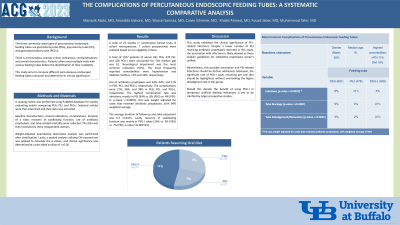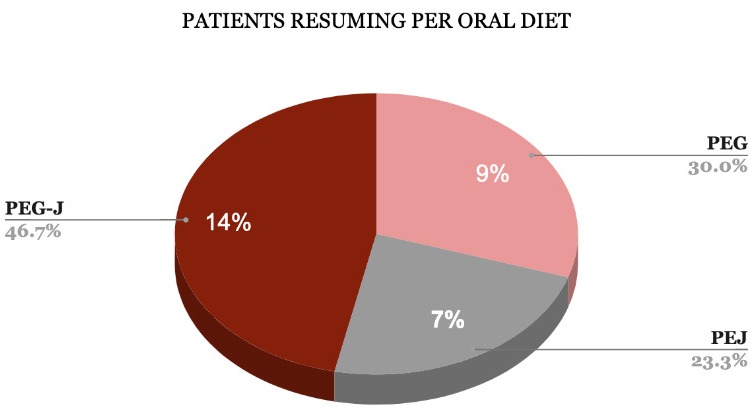Monday Poster Session
Category: Stomach
P2760 - The Complications and Recovery of Swallowing Function After Percutaneous Endoscopic Feeding Tubes: A Systematic Comparative Analysis
Monday, October 23, 2023
10:30 AM - 4:15 PM PT
Location: Exhibit Hall

Has Audio

Manasik Abdu, MD
University at Buffalo-Catholic Health System
Buffalo, NY
Presenting Author(s)
Manasik Abdu, MD1, Anandita kishore, MD1, Wassel Sannaa, MBBS2, Khalid Ahmed, MD3, Fouad Jaber, MD4, Muhammad Tahir, MD5
1University at Buffalo-Catholic Health System, Buffalo, NY; 2Mayo Clinic, Rochester, MN; 3The Wright Center for GME, Scranton, PA; 4University of Missouri-Kansas City, Kansas City, MO; 5University at Buffalo, Buffalo, NY
Introduction: The three commonly used types of percutaneous endoscopic feeding tubes are gastrostomy tube (PEG), jejunostomy tube (PEJ), and gastrojejunostomy tube (PEG-J). There is a tremendous overlap in their indications, contraindications, and overall characteristics. Patients often need multiple trials with various feeding tubes before the identification of their suitability. This study aims to compare different percutaneous endoscopic feeding tubes outcomes and determine its clinical significance.
Methods: A scoping review was conducted using PubMed to analyze studies comparing PEG, PEJ, and PEG-J tubes. Baseline characteristics, clinical indications, complications, tube duration, swallowing function recovery, antibiotic prophylaxis use, and tube-related mortality were examined. The data was independently reviewed by three authors. Weight-adjusted descriptive analysis was performed, and a pooled analysis with the Chi-squared test determined clinical significance (p ≤ 0.05).
Results: 22 studies (7 randomized clinical trials, 8 retrospective cohorts, 7 prospective cohorts) included 1597 patients (691 PEG, 478 PEJ, 428 PEG-J). Median age was 61, and neurological impairment was the most common indication (55%). Hypertension and diabetes were the most reported comorbidities (11% and 10% respectively). Antibiotic prophylaxis usage was 54% (PEG), 44% (PEJ), and 11% (PEG-J). Complication rates were 27% (PEG), 36% (PEJ), and 38% (PEG-J). Infections were the most common complication, especially in PEJ (34% vs. 8% PEG vs. 4% PEG-J; p-value =< 0.0001) with a 94% weighted average for cases receiving antibiotic prophylaxis. Average follow-up and tube placement duration was 6.5 months. Swallowing function recovery was highest in PEG-J tubes (14% vs. 9% PEG vs. 7% PEJ; p-value =< 0.001533).
Discussion: This study highlights the clinical significance of PEJ-related infections. However, the association with infections may be influenced by variations in antibiotic prophylaxis guidelines across studies. Further investigation is needed to address this association and PEJ-related infections. Additionally, the notable rate of PEG-J cases resuming oral diet should be emphasized, while considering the higher dislodgment rate in this group. More studies are needed to clarify the potential benefits of using PEG-J for temporary artificial feeding indications.

Disclosures:
Manasik Abdu, MD1, Anandita kishore, MD1, Wassel Sannaa, MBBS2, Khalid Ahmed, MD3, Fouad Jaber, MD4, Muhammad Tahir, MD5. P2760 - The Complications and Recovery of Swallowing Function After Percutaneous Endoscopic Feeding Tubes: A Systematic Comparative Analysis, ACG 2023 Annual Scientific Meeting Abstracts. Vancouver, BC, Canada: American College of Gastroenterology.
1University at Buffalo-Catholic Health System, Buffalo, NY; 2Mayo Clinic, Rochester, MN; 3The Wright Center for GME, Scranton, PA; 4University of Missouri-Kansas City, Kansas City, MO; 5University at Buffalo, Buffalo, NY
Introduction: The three commonly used types of percutaneous endoscopic feeding tubes are gastrostomy tube (PEG), jejunostomy tube (PEJ), and gastrojejunostomy tube (PEG-J). There is a tremendous overlap in their indications, contraindications, and overall characteristics. Patients often need multiple trials with various feeding tubes before the identification of their suitability. This study aims to compare different percutaneous endoscopic feeding tubes outcomes and determine its clinical significance.
Methods: A scoping review was conducted using PubMed to analyze studies comparing PEG, PEJ, and PEG-J tubes. Baseline characteristics, clinical indications, complications, tube duration, swallowing function recovery, antibiotic prophylaxis use, and tube-related mortality were examined. The data was independently reviewed by three authors. Weight-adjusted descriptive analysis was performed, and a pooled analysis with the Chi-squared test determined clinical significance (p ≤ 0.05).
Results: 22 studies (7 randomized clinical trials, 8 retrospective cohorts, 7 prospective cohorts) included 1597 patients (691 PEG, 478 PEJ, 428 PEG-J). Median age was 61, and neurological impairment was the most common indication (55%). Hypertension and diabetes were the most reported comorbidities (11% and 10% respectively). Antibiotic prophylaxis usage was 54% (PEG), 44% (PEJ), and 11% (PEG-J). Complication rates were 27% (PEG), 36% (PEJ), and 38% (PEG-J). Infections were the most common complication, especially in PEJ (34% vs. 8% PEG vs. 4% PEG-J; p-value =< 0.0001) with a 94% weighted average for cases receiving antibiotic prophylaxis. Average follow-up and tube placement duration was 6.5 months. Swallowing function recovery was highest in PEG-J tubes (14% vs. 9% PEG vs. 7% PEJ; p-value =< 0.001533).
Discussion: This study highlights the clinical significance of PEJ-related infections. However, the association with infections may be influenced by variations in antibiotic prophylaxis guidelines across studies. Further investigation is needed to address this association and PEJ-related infections. Additionally, the notable rate of PEG-J cases resuming oral diet should be emphasized, while considering the higher dislodgment rate in this group. More studies are needed to clarify the potential benefits of using PEG-J for temporary artificial feeding indications.

Figure: Patients Resuming Oral Diet
Disclosures:
Manasik Abdu indicated no relevant financial relationships.
Anandita kishore indicated no relevant financial relationships.
Wassel Sannaa indicated no relevant financial relationships.
Khalid Ahmed indicated no relevant financial relationships.
Fouad Jaber indicated no relevant financial relationships.
Muhammad Tahir indicated no relevant financial relationships.
Manasik Abdu, MD1, Anandita kishore, MD1, Wassel Sannaa, MBBS2, Khalid Ahmed, MD3, Fouad Jaber, MD4, Muhammad Tahir, MD5. P2760 - The Complications and Recovery of Swallowing Function After Percutaneous Endoscopic Feeding Tubes: A Systematic Comparative Analysis, ACG 2023 Annual Scientific Meeting Abstracts. Vancouver, BC, Canada: American College of Gastroenterology.
